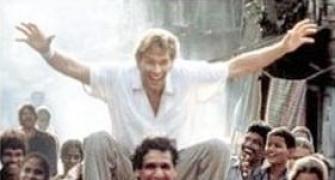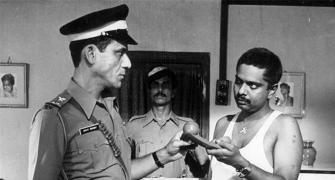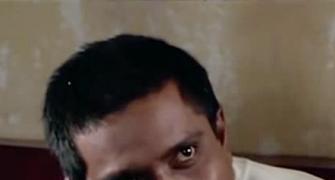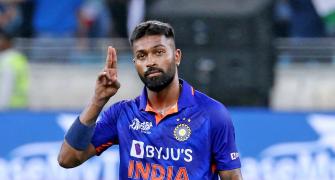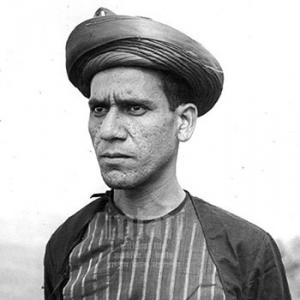'The ending Vijay Tendulkar had written was different.'
According to him, the film ended with Anant Welankar's suicide.'
'I felt such an ending would be too nihilistic.'
'Bahut zyada defeatist ho jaata.'

Almost every cop film that followed Govind Nihalani's hard-hitting drama Ardh Satya owes an allegiance to it, one way or another.
The stunning film was released in 1983, during the year when Jeetendra's southern remakes like Himmatwala, Mawaali and Justice Chowdhary ruled the box office.
It was also the year when Rajesh Khanna had his last spate of hits as a leading man in films like Avtaar, Agar Tum Na Hote and Souten.
As far as cops dramas in commercial cinema were concerned, there was Andha Kanoon where Hema Malini played a cop.
This was certainly no year for a brutal, unrelentingly intense study of crime, punishment, the law and its subversion by powerful goons and politicians.
Eminent playwright Vijay Tendulkar, whose speciality were works on socio-political oppression, had earlier penned the screenplay for Nihalani's directorial debut Aakrosh, where Om Puri -- in one of Indian cinema's most striking performances -- ended his unlettered mute tribal character's self-imposed silence with a bloodcurdling scream of protest.
In Ardh Satya, Om's character of the conflicted compromised cop Anant Welankar protests far more violently.
At the end, he jumps out of his chair and heads straight for the villain Rama Shetty's (Sadashiv Amrapurkar) throat, choking him to death and walking out of the goon's den, riding his motorcycle back to his police station to surrender for the 'crime'.
And why not?
If our socio-political system stifles the straight-thinking, upright civil servant, why should he not smother the living daylights out of a goon, who sits scoffing at Anant's entire career of honest professionalism?
The relevance of Ardh Satya in this day and age of growing compromises remains.
The police force remains viciously maligned. And the conscientious cops, who dare to think and act straight, find themselves ostracised and even declared insane!
The powerlessness of Anant Welankar is the impotency of the Indian bureaucracy. It functions more by tradition rather than integrity.

Om's cop character is not a larger-than-life hero.
He is a hurting middle class Marathi boy from the village with a troubled childhood.
With a bully of a father (Amrish Puri, bleeding brilliancy into the drama with his brief role), who beats up his hapless mother, Anant grows up despising all that his father represents.
Yet, paradoxically, Anant is a bully is his own work space.
In a shocking departure from conventional cinema, Nihalani captured the hero's life in all its ordinary hues.
We see the cop covering his beat in the small lanes and chawls of Mumbai.
We see him picking up petty criminals and thrashing them for small crimes to vent his frustration.
We see him drinking on the job and calling the girl he loves at her hostel, screaming for attention.
We see him getting progressively embittered by the corruption all around him.
We see him spurning his father's paternal concern reminding the shocked old man, 'Tu meri maa ko peetta hai.'
And then in the night, we see Anant putting a blanket on his sleeping father.
The character's biggest virtue is that it doesn't try to be anything except what it really is... an ordinary government officer trying to be honest to his job.

Nihalani cast Om Puri to capture the texture of ordinariness in Mumbai's underbelly. The locations reek of a clamped-down corruption.
Mumbai in 1983 was a city waiting to split wide open to reveal the wide chasm between the world of the working class and the layer of crime just beneath.
As Anant Velankar transcends into a kind of middle class despondency that comes to the upright when they're compromised, we begin to sense his despair and embrace it wholeheartedly.
The demonisation of the duty-conscious cop is palpable in scene like the one where Anant snaps at the elderly constable, who gently admonishes him for drinking on duty. Or each time he rings up the mortified Jyotsana and slurs in a drunken haze.
Throughout the film's jagged journey, Jyotsana, as played by Smita Patil, remains the symbol of all things pure and idealistic, sometimes naively so.
Smita represents that breed of intensely committed women in starched cotton saris, who believe they can change the world through seminars and morchas.
While most of Ardh Satya strikes me as being relevant to our times, Smita's flag-waving idealism to the point that she tells her cop boyfriend to give up his job or his love for her, struck me as somewhat impractical.
The world that Nihalani's film embraces has no place for jingoism.
It's a cut-throat Mumbai where every section of people bully the underdog.
We see a lot of sadistic violence in Ardh Satya.
Unlike other harbingers of social change, who came in to make films in the 1970s and '80s, Nihalani was not afraid of violence. He never flinches away from the dark areas of his hero's psyche.
Nihalani gets unostentatious actors to play Anant's colleagues at the police station.
Shafi Inaamdar, as Hyder his immediate senior, is a portrait of benign pragmatism. Hyder knows we live in troubled times, and the sooner we stop trying to change society, the better the chances of our survival.
On Govind Nihalani's 83rd birthday on December 19, Subhash K Jha locates an earlier interview where the director says, "If there were other films in the genre before Ardh Satya, I am not aware of it. My films have always been driven by character. So whatever the right environment for my characters, I let them inhabit their natural world."
Ardh Satya is even more relevant today than it was when it was made.
We hadn't really thought about how it would finally turn out. It was after Aakrosh which Vijay Tendulkar had written.
We were discussing what to collaborate on next.
Many ideas came to mind, and Tendulkar suggested a short story Surya by D A Panvalkar.
I read the story. It was about a policeman.
But the story didn't have the soul to sustain a feature film.
So I brainstormed with Tendulkarji, imagining what would happen to this cop in the real world.
I came up with some suggestions like, 'Suppose the cop was asked to protect the same criminal whom he stands up against?'
Finally, the original story was seen in only three-four scenes in the film.
During that time, Tendulkarji was on a Homi Bhabha Fellowship on the expression of violence in society as reflected in Marathi theatre.
He was also a journalist, so his knowledge of Mumbai, the middle class of Maharashtra and its underbelly was really deep and insightful.
He knew the characters in Ardh Satya. The context of exploration was very much in his area of experiences.

The shocking finale when Anant Welankar strangulates the goonda Rama Shetty still jolts us out of our seats.
The ending that Tendulkar had written was different.
According to him, the film ended with Welankar's suicide.
It ended with Smita's character coming to Om's house and discovering him dead.
I felt such an ending would be too nihilistic. Bahut zyada defeatist ho jaata.
I wanted the ending to be different.
If we went by the theory of existentialism, then the protagonist would have to bear the consequences of his action.
To let Welankar live and pay for his consequences, according to me, demanded greater strength than death.
I told Tendulkarji about my ending.
He was remarkably open-minded about it.
He said, 'I've told you how I think it should end. However, it's your film. You decide. My advice is to not change my ending.'
I respected Tendulkarji too much to just go ahead and do my own thing.
What did you do?
I shot both endings. Unfortunately, the other ending is lost.
I don't have the footage.
But I shot and edited both.
Then?
I screened both the endings. Only Tendulkarji and I were there at the screening.
We saw the entire film twice, with his ending and my ending.
After that, we thought about it for some time.
Then he said, 'In the way that you've developed the characters, your ending works better. So go ahead with your ending.'
If Tendulkarji had not agreed, would you have gone with his ending?
I was ready to go by his ending.
I couldn't dream of transgressing his creativity.
But he appreciated my conviction and my respect for him. I've always respected my writers.

Mumbai's underbelly has become a stereotypical location for crime dramas.
This genre of cinema depicting Mumbai's underworld had not taken over.
If there were other films in the genre before Ardh Satya, I am not aware of it.
My films have always been driven by character.
So whatever the right environment for my characters, I let them inhabit their natural world.
Smita's character Jyotsana is a middle class college lecturer, so she is bound to travel by buses.
Smita's character seems naively idealistic.
Why do you think so?
Jyotsana is just in her 20s, out of college.
I have always been criticised for not making my women strong, but look at Jyotsana in Ardh Satya.
Look at her intellectual sophistication.
She knows Anant is a policeman.
She recognises the suppressed violence in him.
She realises one cannot separate the individual from what one does.
Here's a woman who is eligible. But she takes a cold, dispassionate decision beyond romantic notions of love and leaves Anant.
How can you think of her as naïve? She's progressive and mature.

Om Puri considered you as his mentor.
I don't see myself as his mentor.
His career was made on the basis of his talent.
The film was not conceived to showcase Om's talent.
Is it true that you wanted Mr Amitabh Bachchan for the role?
Not true at all. It was Om all the way. There are certain false notions about the character.
Anant Velankar is often interpreted as an honest cop.
For me, it was very important to put forward the inner transformation of the character's journey.
Anant was a reluctant cop.
His father forced him into the police force. He has a soft, sensitive, poetic side.
Having been forced into the police force, Anant discovers the arbitrary power of the khaki uniform.
He tries to keep his soul away from corruption.
He is constantly trying to check his anger and his self-loathing for not being able stop his mother from being brutalised by his father.
Then again, he couldn't stop his father from forcing him to become a cop.
There's anger and frustration at not being able to stop his humiliation, and he takes it out by exercising brute force at work.
Some may consider this amateur psychology but a lot of the so-called complexities of life are actually very simple to explain.

You have shown Anant's bitter rage being manifested in terrible thoughts of impotency and emasculation?
Anant feels the system is castrating him.
In fact, Anant's colleague Hyder says, 'So long as you have a uniform, you have hope.'
Hyder urges Anant to strike a deal with the goon Rama Shetty.
In his naivete, Anant thinks he can strike a deal with the criminal without compromising his principles.
While striking a deal, he discovers the price he has pay, that is, total surrender to the goon's wishes.
Anant asks, 'Tum chahte ho tum thooko main chaatoon?'
Anand therefore reacts. He kills rather than take the humiliation. It's not a moment of heroism.
That completes Anant's journey from the coward and weakling, who can't confront his father to the man who is ready to face the consequences of his action.
Anant must not be seen as a virtuous, idealistic cop.
I see Anant as a complex character, trying to negotiate an environment that gives him a sense of arrogant power. Then suddenly, he realises the power is an illusion.
Apart from Om, the other startling performance came from Sadashiv Amrapurkar as the villain Rama Shetty.
Right from the start, I knew I needed a fresh face for that character.
I asked Vijay Tendulkar about it and he recommended Sadashiv.
I found his face and eyes interesting.
I wanted someone who looks like a person from Karnataka.
He fit the bill, but I hadn't seen his work.
He invited me to a play the next day with Bharti Barve.
They were performing a farcical play where Sadashiv was playing a bumbling policeman.
I was astounded by his comic timing.
I took a chance and cast him without any screen test. I am glad I was right.

Naseeruddin Shah, in a cameo, is still remembered.
His character of the burnt-out, alcoholic cop had to be a mirror image of what Anant Velankar could have turned into.
He had just four scenes.
I was very grateful to Naseer for doing a cameo after playing the protagonist in Aakrosh.


